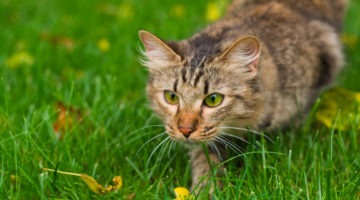It’s one of the most common diseases seen in felines. Here’s what you need to know about integrative treatment and prevention.
Flurry was ten years old when he was diagnosed with diabetes. His human family was shocked and devastated, but unfortunately they’re far from alone. Diabetes is one of the top diseases seen in cats. While many of these animals require insulin therapy for the rest of their lives in order to properly regulate their blood sugar, the good news is that many others can do fine without it. This article will explore some natural approaches to helping a diabetic cat.
What causes diabetes?
Diabetes mellitus (DM or diabetes for short) is the second most common endocrine disease in cats, after hyperthyroidism. It can occur at any age but typically shows up in middle-aged to older cats. While it’s easy to diagnose, there are many causes:
- Amyloidosis, the deposition of amyloid protein in the pancreas
- Pancreatitis, which often develops secondary to inflammatory bowel disease and hepatic lipidosis
- Chronic use of corticosteroids, especially injectable Depo Medrol
- Immune destruction of the pancreas due to autoimmune mechanisms
- Often, the cause is unknown
Cinnamon can be effective for lowering blood sugar levels and is often included in herbal supplements for animals with diabetes.
As is true in humans (and very rarely in dogs), cats can experience either type I or type II diabetes. Type I diabetes is also called insulin dependent diabetes, and usually requires insulin therapy for the lifetime of the cat. However, a few of these cats may be successfully weaned off insulin, especially if their diets are well controlled and they are taking supplements that have glucose lowering effects (see next page).
Type II diabetes is non-insulin dependent and usually does not require insulin therapy; in many cases, it’s a temporary problem that occurs as a result of stress or exposure to medications such as corticosteroids. Type II diabetic cats do not require insulin and can have their blood sugar maintained with diet, exercise and natural therapies.
How is it diagnosed?
Typical clinical signs include excessive thirst (polydipsia), excessive urination (polyuria) and increased appetite (polyphagia). Weight gain or loss may or may not occur. These signs are not specific to diabetes; other diseases in middle-aged to older cats, such as hyperthyroidism and kidney failure, can cause similar clinical signs. Fortunately, blood and urine testing is usually all that’s necessary to properly diagnose diabetes in cats.
Insulin or not?
Once a diagnosis of diabetes has been made through testing, clinical signs and a physical examination, it’s important to differentiate between cats that may require insulin and those that do not. This is not always easy.
- In general, cats with mildly elevated blood glucose levels (300 to 400) will probably not require insulin and can be treated solely with natural therapies. It is necessary, however, to continue monitoring their blood and urine glucose levels in the event that insulin therapy may become necessary.
- Cats with extremely high blood glucose levels (500 to 600 or greater) need insulin as part of their initial therapy and will likely require it for the rest of their lives, although some may be weaned off it and can be maintained solely on natural therapies.
- Cats with severely elevated blood and urine glucose levels and/or ketone levels usually require hospitalization for one or more days in an attempt to lower these levels.
While it is tempting to try and make every cat’s blood glucose level “normal” through treatment, the actual number is not always as important as how the cat feels and whether or not clinical signs are still present. Many of my patients are doing well despite having slightly elevated blood glucose levels.
Natural therapies
Many natural therapies can help cats with diabetes. Here are some I have found helpful.
- Phosphatidylcholine is useful for many problems including seizures, cognitive disorders and liver disease. It may also provide support for diabetic cats, and I have one dog that was “cured” of his diabetes when I started him on a phosphatidylcholine supplement called Cholodin. As a result, all my diabetic cats and dogs now receive choline therapy as part of their natural treatment regimen.
- Pancreatic glandulars provide raw pancreatic extract for the cat, in the hopes that the damaged pancreas can heal.
- Cinnamon can be effective for lowering blood sugar levels and is often included in herbal supplements for animals with diabetes.
- Gymnema is an herb well known for its ability to regulate blood sugar. It’s used in many formulas for animals with diabetes.
- Chromium and vanadium are minerals with glucose lowering effects. Because high doses can be toxic, they should only be used under veterinary supervision.
- Various homeopathics may also help improve blood glucose regulation in diabetic cats. Some of the most commonly recommended remedies include homeopathic dilutions of syzygium, curare and phloridzinum.
In general, I will start diabetic cats on some combination of these supplements, and use low-dose insulin if necessary. It is very important to carefully monitor these cats so blood glucose levels don’t fall too low too quickly. Carefully monitoring the cat allows us to properly fine tune his therapy to get maximum results. Each diabetic cat is an individual who requires customized therapy. By working with a holistic veterinarian, you can find the right combination of natural therapies and (when necessary) insulin to keep your diabetic feline alive and healthy for a long time to come.
Diet and exercise
Diet is very important for diabetic cats. Cats are true carnivores and do not have an obligate need for carbohydrates, so a canned or homemade food with minimal grain carbohydrates is ideal for those with diabetes. I recommend feeding several small meals throughout the day. Additionally, exercise is key to helping regulate blood glucose levels. As much as possible, it’s important to turn couch potato cats into active felines using controlled exercise.







No Comment